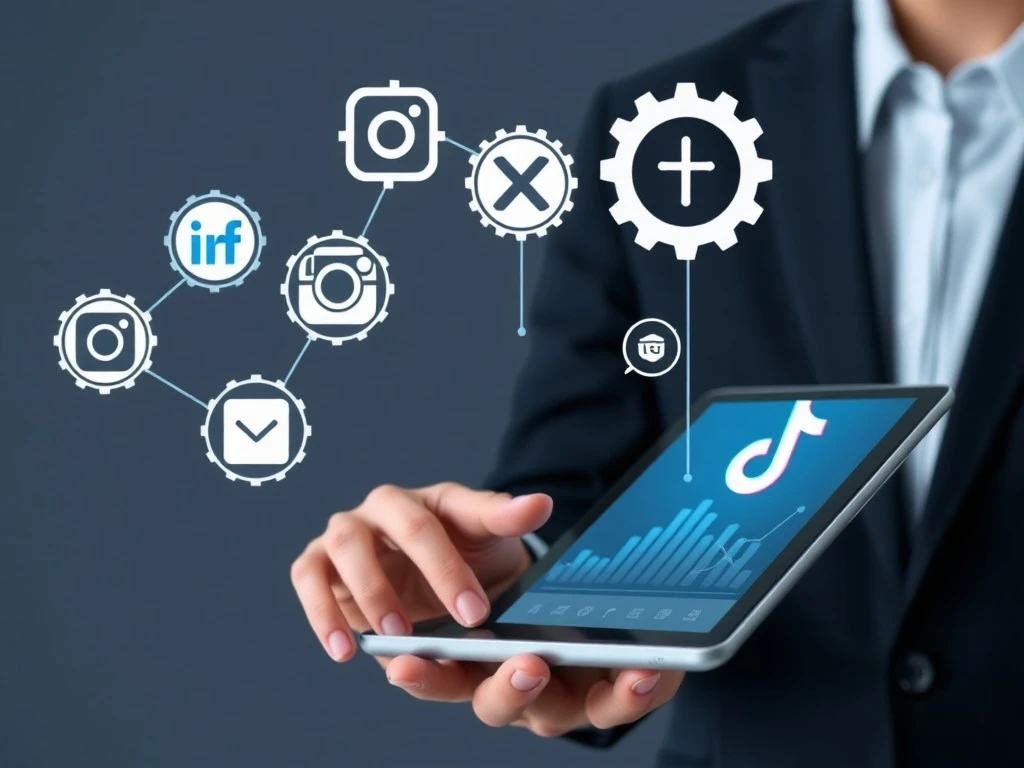In today’s fast-paced digital landscape, managing social media effectively presents a significant challenge for many brands. It demands consistent effort, continuous audience engagement, and ongoing brand presence growth. All this must happen while keeping pace with ever-changing platform algorithms. Leading businesses now leverage social media automation to streamline these critical efforts. They maintain a strong online presence without constant manual input. By putting key processes on autopilot, top brands scale their strategies, save valuable time, and focus more on creativity and big-picture planning.
This article uncovers how top-performing companies utilize automation tools and strategies. They manage their social media channels with remarkable effectiveness. Whether you are a solo entrepreneur or part of a growing marketing team, these insights can help you operate your social channels like the pros.
The Rise of Social Media Automation
The rapid growth of social media platforms creates both immense opportunity and significant pressure for brands. Users are spread across Facebook, Instagram, X (formerly Twitter), LinkedIn, TikTok, and more. Brands are expected to maintain a daily presence on each of these platforms. However, manually posting, responding, and tracking analytics across these diverse platforms quickly becomes overwhelming. This is precisely where social media automation offers a powerful solution.
Tools like Buffer, Hootsuite, Later, and Sprout Social allow brands to schedule posts well in advance. They also manage engagement and track performance, all from one centralized place. Automation helps brands maintain a consistent posting schedule. This consistency is essential for building trust and enhancing visibility. Furthermore, it eliminates the risk of forgetting key dates, such as product launches or seasonal campaigns. Importantly, automation does not remove the human element. Instead, it supports your team with tools that allow more room for strategic planning and quality content creation. Brands that automate smartly remain active without experiencing burnout.
Automating Content Scheduling for Brands
Top brands do not post randomly; they plan meticulously. One of their most effective strategies involves using a comprehensive content calendar. These calendars help teams map out posts weeks or even months ahead. Consequently, brands align content with campaigns, events, and trending topics seamlessly. Social media automation tools facilitate this advanced scheduling.
Using scheduling tools, marketers can queue posts for optimal times. These times are often based on audience engagement patterns. For example, data might show that Instagram users engage more during lunch hours, while LinkedIn performs best in the early morning. By scheduling posts during these peak times, brands significantly increase the chances of their content being seen and shared. Additionally, many tools offer features like automatic reposting of evergreen content. This means popular blog posts, product highlights, or tutorials can be shared again over time. This ensures maximum reach with minimal effort.
Enhancing Engagement with Social Media Automation
Engagement forms the core of social media success. Yet, manually responding to every comment, direct message, or mention consumes vast amounts of time. This is especially true for larger brands with extensive followings. To manage this, leading companies deploy AI-powered tools. These tools provide automated responses for common inquiries. Chatbots, for example, answer questions about store hours or shipping details instantly. Simultaneously, complex or sensitive issues are flagged for human review.
Some platforms also offer smart moderation features. They automatically hide spammy or offensive comments. This keeps brand pages clean and professional without requiring constant manual oversight. However, the most successful brands balance automation with authenticity. They prioritize personal responses to key followers and participate in trending conversations. Social media automation handles routine tasks, freeing human teams for genuine connection.
Driving Decisions Through Automated Analytics
One major advantage of social media automation is its ability to gather and interpret data rapidly. Social media analytics tools automatically track key metrics. These include reach, engagement, follower growth, click-through rates, and conversions. Top brands utilize these insights to adjust strategies in real-time. For instance, if a particular type of post performs better on Instagram but falls flat on X, they can shift content accordingly.
Data also identifies optimal posting times and effective hashtags. Furthermore, it reveals which campaigns deliver the highest return on investment (ROI). Instead of spending hours compiling reports, teams receive automated summaries directly to their inboxes. This facilitates faster decision-making and more agile marketing. Automated analytics empowers brands to make informed choices, leading to more effective campaigns and better resource allocation.
Integrating Automation for Broader Impact
For social media automation to achieve maximum effectiveness, it must integrate seamlessly with broader marketing efforts. Successful brands connect their automation tools with CRM systems, email marketing platforms, and e-commerce solutions. For example, a customer purchase or newsletter signup can trigger specific social media messages or ads. Similarly, changes in customer behavior, like abandoning a shopping cart, can automatically initiate a retargeting campaign.
This level of integration ensures consistent messaging across all platforms. It also delivers timely, relevant communication to audiences. Furthermore, it reduces duplicated work, allowing marketing teams to operate more efficiently. Integrated automation creates a cohesive customer journey, improving overall brand experience and driving conversions.
Leveraging Influencer and User-Generated Content
Top brands understand that social media involves more than their own voice. It also includes the voices of their customers. Many use social media automation to track and repurpose user-generated content (UGC). They also manage influencer collaborations more efficiently. Tools monitor mentions, hashtags, and tags to identify customer posts about the brand. The best content is then curated and scheduled for reposting. Often, automated approval flows are in place.
Influencer campaigns also benefit significantly from automation. Platforms now exist that match brands with influencers. They handle contracts, schedule posts, and track performance with minimal manual effort. This approach not only builds trust but also saves time and authentically expands reach. It allows brands to harness the power of community and authentic endorsements effectively.
Crisis Management and Real-Time Events
Social media crises can escalate very quickly. Top brands remain prepared for such events. Social media automation plays a crucial role in this readiness. It sets up alerts and workflows that activate during unusual activity. For instance, a sudden surge in negative comments or mentions triggers notifications for the PR team. Pre-approved responses or holding statements can be automatically deployed. Meanwhile, the situation is reviewed by human staff.
Scheduled posts can also be paused automatically to avoid appearing insensitive or out of touch during a crisis. This level of readiness helps brands maintain control over their image, even during unexpected occurrences. Automation ensures a swift and coordinated response, protecting brand reputation when it matters most.
Scaling Teams with Automation Tools
As brands expand, so do their teams. Manually managing multiple users, roles, and approval processes creates bottlenecks. To address this, social media automation tools include features for customized permissions and workflows. A junior marketer, for example, can create content. A manager must then approve it before it goes live. Notifications ensure nothing is missed. Audit trails provide transparency for all actions taken.
This streamlines collaboration. It also maintains quality control, especially for global teams working across different time zones. Automation facilitates efficient teamwork, allowing brands to grow their social media presence without compromising on consistency or brand voice.
The Future: AI and Predictive Social Media Automation
The future of social media automation increasingly relies on AI and predictive tools. Leading brands already utilize machine learning. This identifies trending topics, suggests hashtags, and even generates content ideas based on past performance. Some tools now offer automated caption writing, image recognition, and voice-to-text features. These advancements reduce content creation time. They also increase consistency across platforms.
Additionally, predictive analytics help forecast campaign outcomes. They optimize ad spend and refine content calendars. Brands leveraging these technologies gain a competitive advantage. They stay ahead of the curve effectively. AI-powered automation promises even greater efficiency and personalization in social media management.
Final Thoughts
Top brands do not achieve social media success by chance. They implement well-planned strategies. These are supported by powerful social media automation tools. Automation streamlines processes, maintains consistency, and boosts engagement. From scheduling posts to analyzing data, and from customer responses to crisis management, automation empowers them. It helps them stay ahead without burnout.
If you seek to elevate your social presence, adopting smart automation is no longer optional; it is essential. Start small, select appropriate tools, and build a system that supports your goals. Remember to leave room for genuine human connection. This approach truly puts your social media on autopilot while remaining personal.
Frequently Asked Questions (FAQs)
What is social media automation?
Social media automation involves using software and tools to manage and streamline various social media tasks. This includes scheduling posts, analyzing data, managing engagement, and integrating with other marketing efforts. It aims to save time and increase efficiency.
How does social media automation maintain authenticity?
While automation handles routine tasks, top brands balance it with human interaction. Automated tools manage common inquiries and scheduling, freeing human teams to focus on personalized responses, engaging with key followers, and participating in meaningful conversations. This blend ensures both efficiency and genuine connection.
What tools do top brands use for social media automation?
Leading brands commonly use platforms like Buffer, Hootsuite, Later, and Sprout Social. These tools offer comprehensive features for scheduling, analytics, engagement management, and team collaboration. Advanced brands also integrate AI-powered solutions for content generation and predictive analytics.
Can social media automation help with crisis management?
Yes, automation plays a crucial role in crisis management. It can set up real-time alerts for unusual activity, such as a sudden spike in negative mentions. It also allows for the quick deployment of pre-approved responses or the pausing of scheduled content to maintain brand control and sensitivity during unexpected events.
What are the benefits of integrating social media automation with other marketing tools?
Integrating social media automation with CRM, email marketing, and e-commerce platforms ensures consistent messaging across all channels. It allows for triggered social media actions based on customer behavior, reduces duplicated efforts, and provides a more holistic view of customer interactions. This integration ultimately drives more effective campaigns and a seamless customer journey.
























